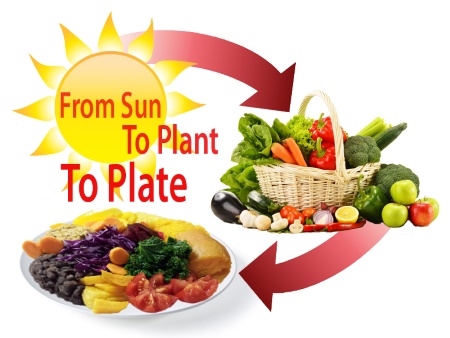A whole-food, nutrient-rich, plant-based diet consists of natural, unprocessed foods that are grown and found in nature. This would include a variety of whole, intact grains, whole grain pasta and breads, starchy vegetables such as corn and potatoes, non-starchy and green leafy vegetables, fruits, beans and legumes, minimally processed organic soy, and a small amount of nuts and seeds. These basic food groups support optimal health and longevity and are shown in the Power Plate graphic by The Physician's Committee for Responsible Medicine. This graphic plate from PCRM is very helpful in helping you to choose what you put on your plate. There are are a few other plate concepts worth looking at as well which I will share below.
 In my Starch-Smart® System you will also notice a focus on simple plant based foods that derive energy through photosynthesis. Essentially energy comes From Sun to Plant to Plate. On the picture of one of my breakfast plates you will notice the slogan "Beans, Greens, Squash and Yams." These foods represent categories of high nutrient and high starch options that you should think of as staples. They do not by any means represent limiting your diet to only these items. Instead, this is a way to think about always having plenty of easy to prepare, satisfiying (bulky, filling) foods on hand at all times. I encourage you to surround yourself with food that is healthy. Try to never allow yourself to become hungry without healthy food in your nearby orbit available to eat. Being prepared is the secret to success.
In my Starch-Smart® System you will also notice a focus on simple plant based foods that derive energy through photosynthesis. Essentially energy comes From Sun to Plant to Plate. On the picture of one of my breakfast plates you will notice the slogan "Beans, Greens, Squash and Yams." These foods represent categories of high nutrient and high starch options that you should think of as staples. They do not by any means represent limiting your diet to only these items. Instead, this is a way to think about always having plenty of easy to prepare, satisfiying (bulky, filling) foods on hand at all times. I encourage you to surround yourself with food that is healthy. Try to never allow yourself to become hungry without healthy food in your nearby orbit available to eat. Being prepared is the secret to success.
For More Ideas:
(2) Jeff Novick's Healthy Eating Placemat